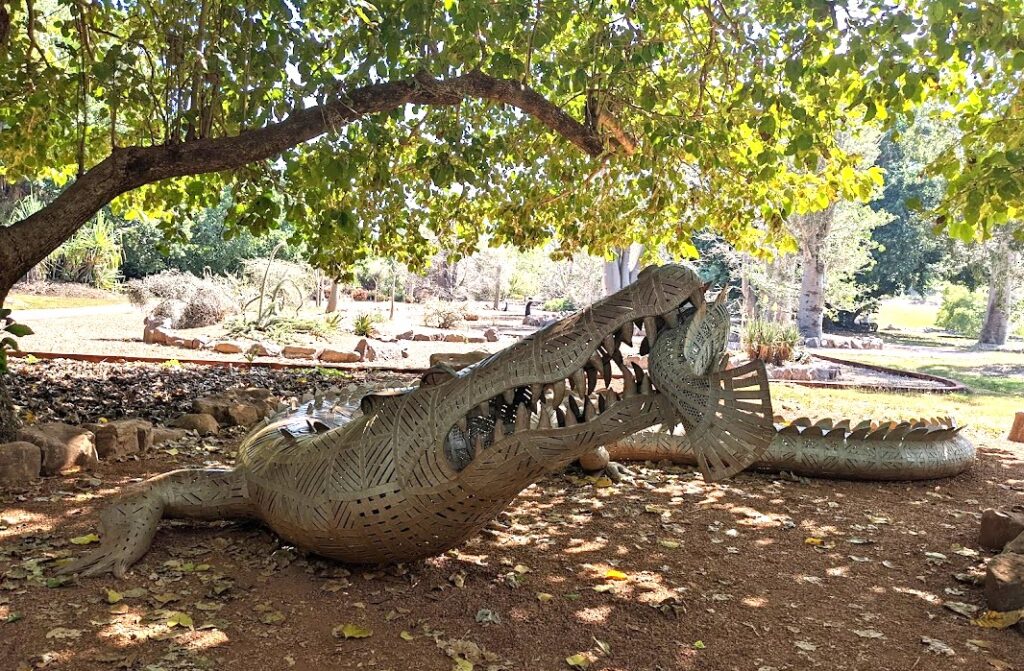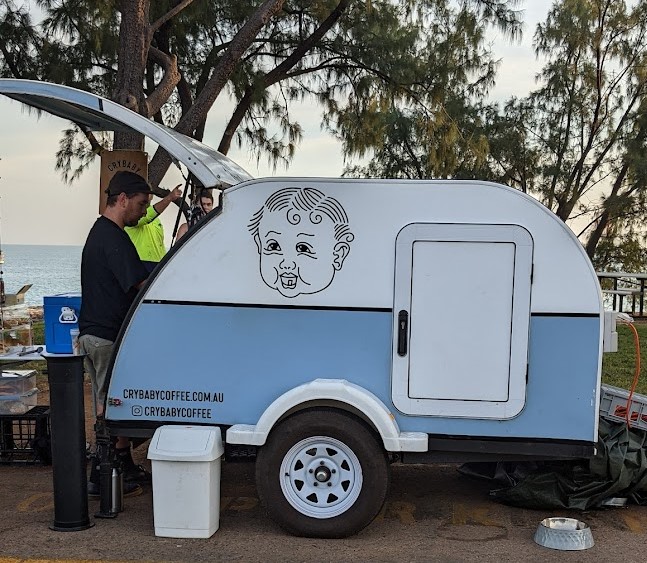
A jetty floats above a still, blue sea. Masked lapwings and ibis, tiny double-barred finches and those small but sturdy ‘peaceful’ doves peck about in the grass. Honey eaters dance in the branches of the fig trees with their pendulous leaves. A black kite rides the wind currents overhead. And can you hear the gentle susurration of a breeze through the casuarinas?
A brolga paddles in a lagoon beside the railway track, another wades through the wetlands at Litchfield. And could that be a wedge tailed eagle feeding on a dead wallaby in the middle of the road? Balletic in the sky, the thickset raptor is ungainly on the ground, hopping hurriedly, awkwardly into the bush as we drive past. At Katherine Gorge a data bird poses on a rock, warily eyeing a couple of “freshies” (crocodiles) lying sleepily on a tree trunk that has fallen into the river. A wallaby and her adolescent baby feed cautiously by the side of the road. A pair of scrub fowl rummage amongst the leaf litter for breakfast. What is it about seeing animals and birds in the wild, in their own habitat, that makes it so much more special than seeing them in a cage in the zoo?
It’s my first visit to the Top End, and Zia’s too. Wisely, we have come during the cooler months. The mornings are blue and gently warm. By mid-afternoon we agree to search out the shade or the air conditioning. The evening sunsets are spectacular, as that deep orange orb sinks into the sea and paints the sky with broad brush strokes of peach and apricot and blood orange.
A weekend of local markets, where the aroma of barbecued satays makes me nostalgic for our long-lost Philipino markets. At Parap we are offered a Thai massage. Feet and shoulders? Yes please! “Khap khun kah!” We sit in the tent and watch the world go by as the girls knead the knots from our necks. There are so many babies in Darwin. Thongs (flip flops) are the ubiquitous footwear. On Sunday we discover another village market only a ten minute walk from our Airbnb in Nightcliff. Food, craft, jewellery, clothes… how much can I squeeze into my suitcase?
Our go-to for morning coffee is a converted caravan by the beach: ‘Crybaby’s.’ (Maybe that’s what we can do with our own delinquent campervan!) Lunch on the run – at the market or a picnic in the bush, sharing crumbs with the oddly translucent ghost ants. Dinner revolves around sunsets: a seafood restaurant above the beach at Cullen Bay; the Trailer Boat Club further up the coast at Fannie Bay; a sunset cruise from Dock 2. This last is the grand finale, skirting the edge of an unadorned harbour five times the size of Sydney’s. Trimmed with mangroves and rocky outcrops, and home to enough saltwater crocodiles to dissuade even the keenest swimmer – although apparently the “sea wasp” or box jellyfish is an equally nasty threat.
We decide not to spoil a lovely holiday by tempting fate. Instead, we head out to Buley Rockhole, in the Litchfield National Park, armed with our bathers. Buley turns out to be a series of rockpools that requires a little cautious scrambling over rocks, and an even more cautious descent on slippery rocks into the water. It is worth the effort. Deep enough to duck under, the water rushes over the rocks above, into our waist deep pool and down to the deeper pool below, cool and clear, effectively removing the pressure on my head from trudging through the heat all morning. Utter bliss!
But I have rushed ahead. First, we have to get there, driving 100kms south from Darwin through Berry Springs. Litchfield National Park is no city park of a few acres. Established in 1985, this one covers almost 1,500 km2. We pass termite mounds that look like sci-fi cities, built north/south to avoid exposure to the direct heat of the sun. Some signposts indicate dirt tracks only accessible with a 4-wheel drive, but there is still plenty to see in our small rental car.
We walk through the bush to the Lower Cascades, hidden behind the dense undergrowth. Although we can hear them clearly, splashing and gurgling, they seem unreachable. We skirt around impenetrable bush, frustrated by the sound of rushing water, hoping the next turn in the sandy track will expose them to view, but it’s not to be. Above the cascades, the water is like glass, reflecting the lanky palm trees as clearly as a mirror. We drive on to Tolmer Falls, one step ahead of the tourist buses, where we read about the flying fox, born aloft and neatly caught in her mother’s wings, which are cupped together like a hammock to prevent the baby nose-diving to the forest floor as she emerges. The waterfall pours over the lip of the plateau above and plunges down the rocks into the deep pool below, fenced off for our safety, in case of crocs. Apparently, the land above is a giant sponge, retaining immeasurable gallons of water in the wet season, and thus able to keep the pool filled throughout the year. After a picnic beneath the trees, we drive on to a lookout deck for a panoramic view that stretches on forever to the south, the horizon hazy thanks to the seasonal bushfires that flourish in the dry season. Both controlled and otherwise, the former are a part of the Northern Territory’s land management; intentional burning used to control wildfires and the weeds, the latter an unavoidable disaster to vast tracts of wilderness.
And then we reach the rockpools, and gratefully immerse ourselves into the coolth. We only have five days here in Darwin, but we love every minute. And we already have a list of places to visit next time. (Kakadu, the Tiwi Islands, a ferry to Wagait Beach). It’s always good to keep a few temptations in reserve. The weather will be colder and greyer, the traffic heavier when we get back to South Australia. In the meantime, a last coffee on the bench overlooking the sea, a warm breeze kissing our shoulders…


